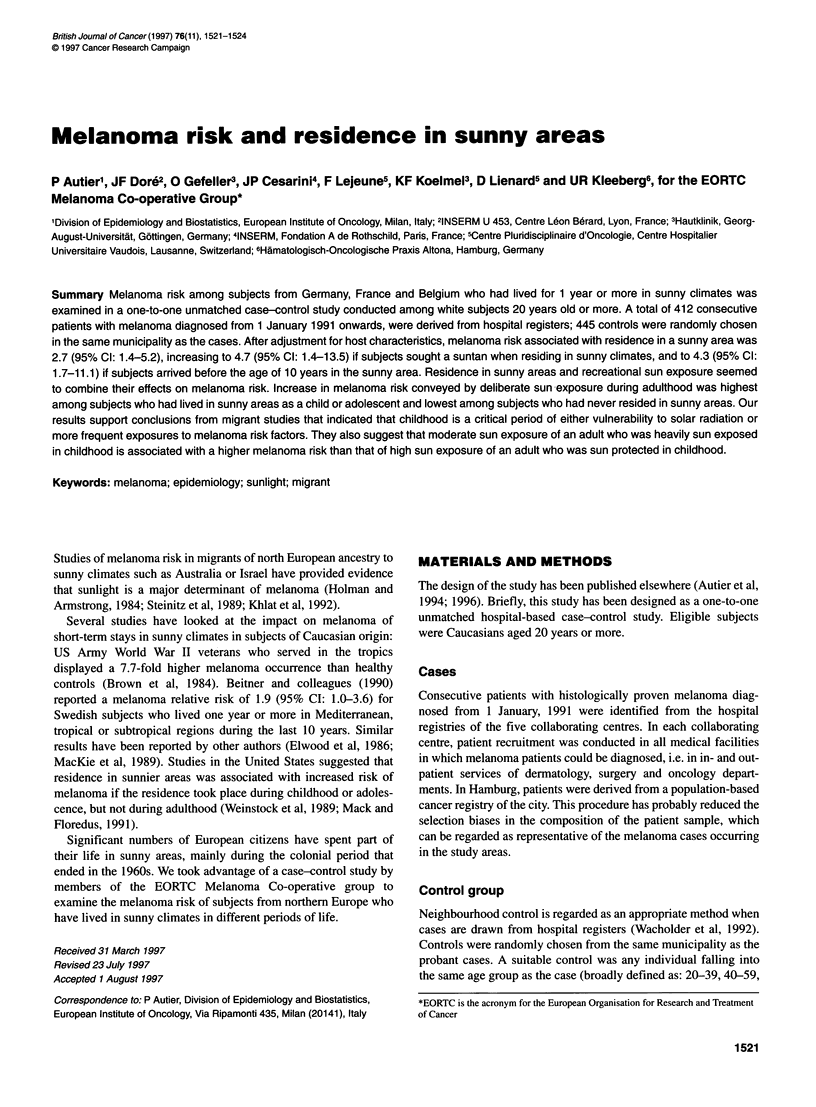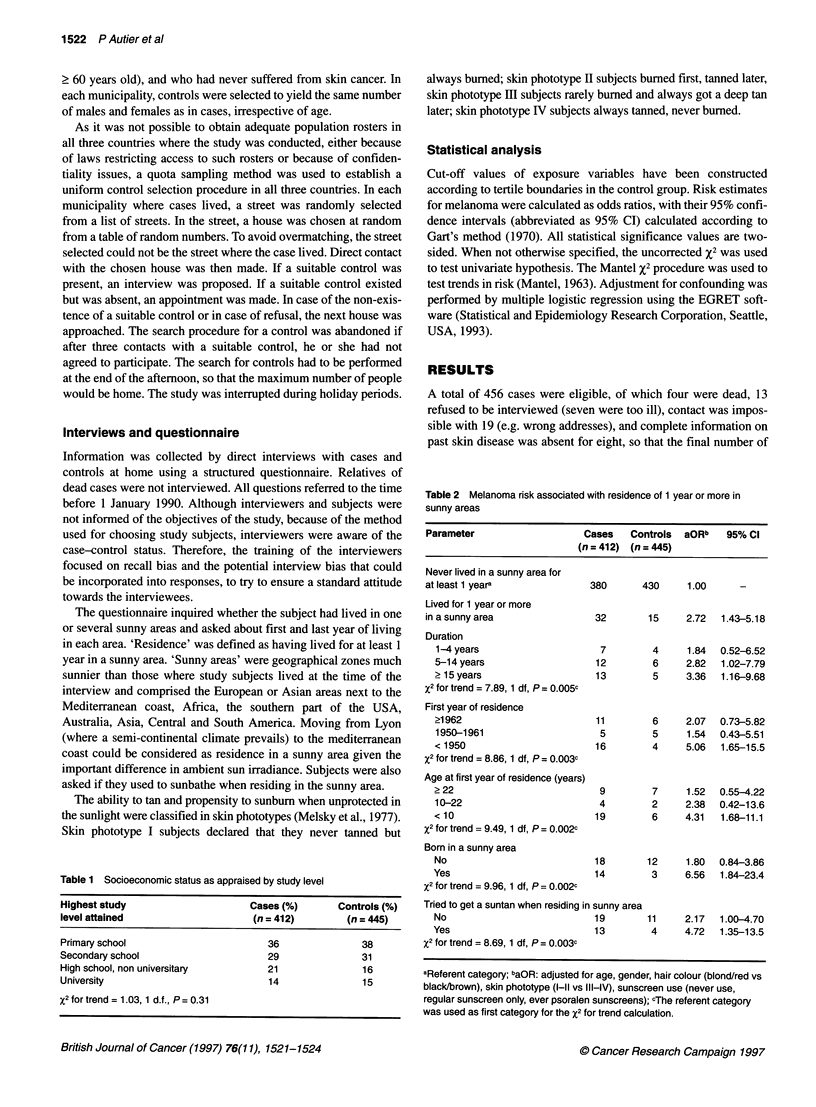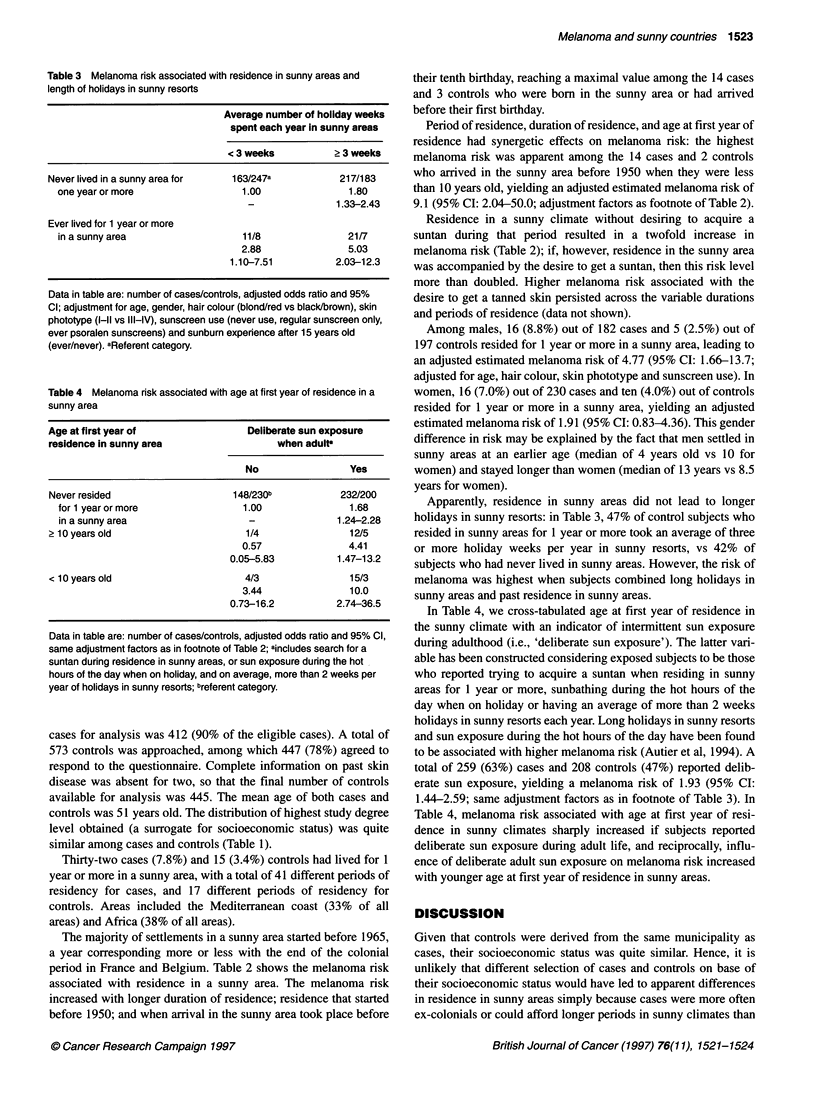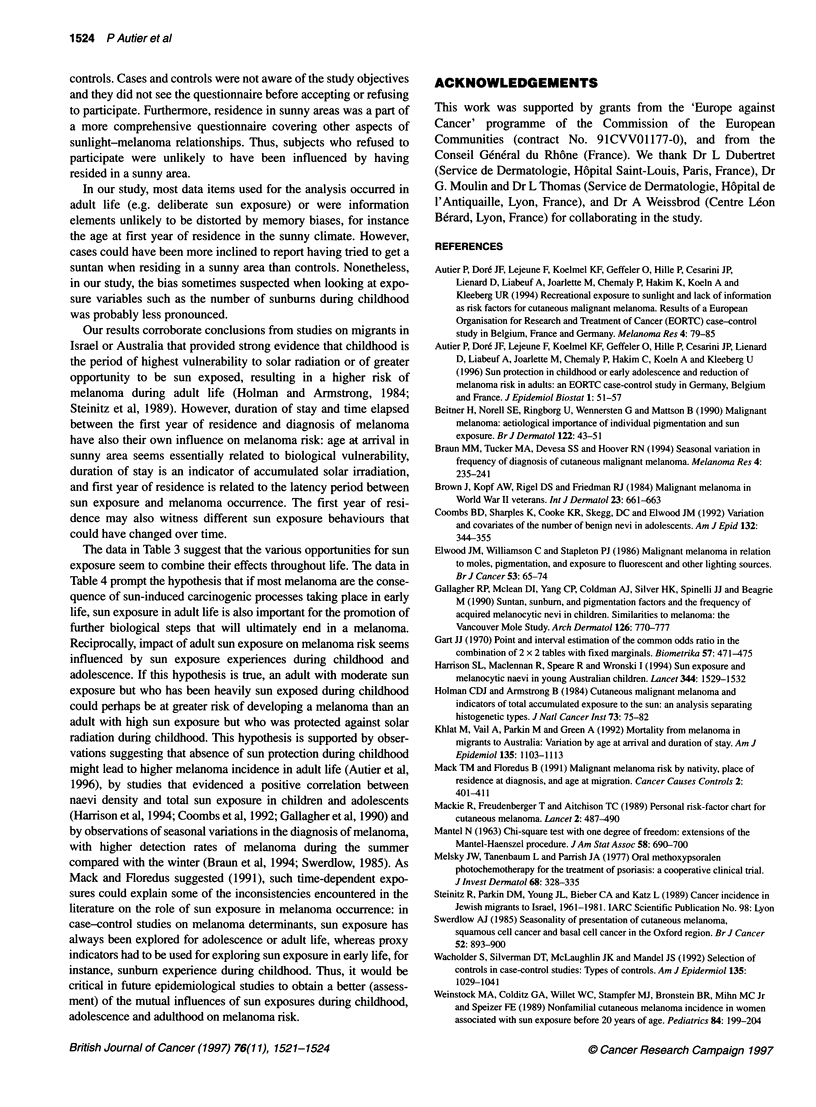Abstract
Melanoma risk among subjects from Germany, France and Belgium who had lived for 1 year or more in sunny climates was examined in a one-to-one unmatched case-control study conducted among white subjects 20 years old or more. A total of 412 consecutive patients with melanoma diagnosed from 1 January 1991 onwards, were derived from hospital registers; 445 controls were randomly chosen in the same municipality as the cases. After adjustment for host characteristics, melanoma risk associated with residence in a sunny area was 2.7 (95% CI: 1.4-5.2), increasing to 4.7 (95% CI: 1.4-13.5) if subjects sought a suntan when residing in sunny climates, and to 4.3 (95% CI: 1.7-11.1) if subjects arrived before the age of 10 years in the sunny area. Residence in sunny areas and recreational sun exposure seemed to combine their effects on melanoma risk. Increase in melanoma risk conveyed by deliberate sun exposure during adulthood was highest among subjects who had lived in sunny areas as a child or adolescent and lowest among subjects who had never resided in sunny areas. Our results support conclusions from migrant studies that indicated that childhood is a critical period of either vulnerability to solar radiation or more frequent exposures to melanoma risk factors. They also suggest that moderate sun exposure of an adult who was heavily sun exposed in childhood is associated with a higher melanoma risk than that of high sun exposure of an adult who was sun protected in childhood.
Full text
PDF



Selected References
These references are in PubMed. This may not be the complete list of references from this article.
- Autier P., Doré J. F., Lejeune F., Koelmel K. F., Geffeler O., Hille P., Cesarini J. P., Liénard D., Liabeuf A., Joarlette M. Recreational exposure to sunlight and lack of information as risk factors for cutaneous malignant melanoma. Results of an European Organization for Research and Treatment of Cancer (EORTC) case-control study in Belgium, France and Germany. The EORTC Malignant Melanoma Cooperative Group. Melanoma Res. 1994 Apr;4(2):79–85. doi: 10.1097/00008390-199404000-00001. [DOI] [PubMed] [Google Scholar]
- Beitner H., Norell S. E., Ringborg U., Wennersten G., Mattson B. Malignant melanoma: aetiological importance of individual pigmentation and sun exposure. Br J Dermatol. 1990 Jan;122(1):43–51. doi: 10.1111/j.1365-2133.1990.tb08238.x. [DOI] [PubMed] [Google Scholar]
- Braun M. M., Tucker M. A., Devesa S. S., Hoover R. N. Seasonal variation in frequency of diagnosis of cutaneous malignant melanoma. Melanoma Res. 1994 Aug;4(4):235–241. doi: 10.1097/00008390-199408000-00005. [DOI] [PubMed] [Google Scholar]
- Brown J., Kopf A. W., Rigel D. S., Friedman R. J. Malignant melanoma in World War II veterans. Int J Dermatol. 1984 Dec;23(10):661–663. doi: 10.1111/j.1365-4362.1984.tb01228.x. [DOI] [PubMed] [Google Scholar]
- Coombs B. D., Sharples K. J., Cooke K. R., Skegg D. C., Elwood J. M. Variation and covariates of the number of benign nevi in adolescents. Am J Epidemiol. 1992 Aug 1;136(3):344–355. doi: 10.1093/oxfordjournals.aje.a116499. [DOI] [PubMed] [Google Scholar]
- Elwood J. M., Williamson C., Stapleton P. J. Malignant melanoma in relation to moles, pigmentation, and exposure to fluorescent and other lighting sources. Br J Cancer. 1986 Jan;53(1):65–74. doi: 10.1038/bjc.1986.10. [DOI] [PMC free article] [PubMed] [Google Scholar]
- Gallagher R. P., McLean D. I., Yang C. P., Coldman A. J., Silver H. K., Spinelli J. J., Beagrie M. Suntan, sunburn, and pigmentation factors and the frequency of acquired melanocytic nevi in children. Similarities to melanoma: the Vancouver Mole Study. Arch Dermatol. 1990 Jun;126(6):770–776. [PubMed] [Google Scholar]
- Harrison S. L., MacLennan R., Speare R., Wronski I. Sun exposure and melanocytic naevi in young Australian children. Lancet. 1994 Dec 3;344(8936):1529–1532. doi: 10.1016/s0140-6736(94)90348-4. [DOI] [PubMed] [Google Scholar]
- Holman C. D., Armstrong B. K. Cutaneous malignant melanoma and indicators of total accumulated exposure to the sun: an analysis separating histogenetic types. J Natl Cancer Inst. 1984 Jul;73(1):75–82. [PubMed] [Google Scholar]
- Khlat M., Vail A., Parkin M., Green A. Mortality from melanoma in migrants to Australia: variation by age at arrival and duration of stay. Am J Epidemiol. 1992 May 15;135(10):1103–1113. doi: 10.1093/oxfordjournals.aje.a116210. [DOI] [PubMed] [Google Scholar]
- MacKie R. M., Freudenberger T., Aitchison T. C. Personal risk-factor chart for cutaneous melanoma. Lancet. 1989 Aug 26;2(8661):487–490. doi: 10.1016/s0140-6736(89)92097-7. [DOI] [PubMed] [Google Scholar]
- Mack T. M., Floderus B. Malignant melanoma risk by nativity, place of residence at diagnosis, and age at migration. Cancer Causes Control. 1991 Nov;2(6):401–411. doi: 10.1007/BF00054301. [DOI] [PubMed] [Google Scholar]
- Melski J. W., Tanenbaum L., Parrish J. A., Fitzpatrick T. B., Bleich H. L. Oral methoxsalen photochemotherapy for the treatment of psoriasis: a cooperative clinical trial. J Invest Dermatol. 1977 Jun;68(6):328–335. doi: 10.1111/1523-1747.ep12496022. [DOI] [PubMed] [Google Scholar]
- Swerdlow A. J. Seasonality of presentation of cutaneous melanoma, squamous cell cancer and basal cell cancer in the Oxford Region. Br J Cancer. 1985 Dec;52(6):893–900. doi: 10.1038/bjc.1985.274. [DOI] [PMC free article] [PubMed] [Google Scholar]
- Wacholder S., Silverman D. T., McLaughlin J. K., Mandel J. S. Selection of controls in case-control studies. II. Types of controls. Am J Epidemiol. 1992 May 1;135(9):1029–1041. doi: 10.1093/oxfordjournals.aje.a116397. [DOI] [PubMed] [Google Scholar]
- Weinstock M. A., Colditz G. A., Willett W. C., Stampfer M. J., Bronstein B. R., Mihm M. C., Jr, Speizer F. E. Nonfamilial cutaneous melanoma incidence in women associated with sun exposure before 20 years of age. Pediatrics. 1989 Aug;84(2):199–204. [PubMed] [Google Scholar]


